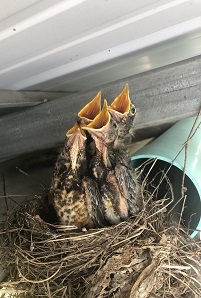Hunting and Trapping Newsletter
The New York State Department of Environmental Conservation sent this bulletin on 05/24/2023 11:00 AM EDT |
| DEC Delivers - Information to keep you connected and informed from the NYS Department of Environmental Conservation |
| View in browser |
Hunting and Trapping Newsletter |
What to Do When Encountering Young Wildlife — If You Care, Leave Them There
As spring moves into full bloom, you may encounter young or newborn wild animals. While a baby animal might appear abandoned, it is much more likely that a parent is in the area or the individual is an independent juvenile. Please do not touch a wild baby animal – call your regional DEC office or a licensed wildlife rehabilitator if you are concerned for its well-being. Many wildlife parents leave their young in a safe place, where they instinctively remain quiet and still to avoid detection by predators. The parents return periodically (sometimes only a few times within 24 hours) to feed the young. Fawns, cottontail rabbits, and fledgling birds are the most common species that are mistakenly “rescued” by people thinking that the animals have been abandoned. Unfortunately, this leads to the death of many young animals, as wildlife is difficult to raise in captivity. It is also illegal to rehabilitate or keep wildlife in captivity without a license. If you come across a young, wild animal on its own, the best thing to do is leave it where it is and observe from a distance. The parents may not approach their young if they sense you in the vicinity. Additionally, DEC reminds the public that young wildlife are not pets. Keeping wildlife in captivity is illegal and harmful to the animal. Wild animals are not well-suited to life in captivity and may carry diseases that can be harmful to humans. Anyone who observes wildlife that appears to be sick or behaving abnormally should contact their DEC regional wildlife office or a wildlife rehabilitator. You can find a list of licensed wildlife rehabilitators as well as more information on young wildlife on the DEC website. Photo courtesy of P. Mercier Broken Record for Oldest Hunter to Successfully Harvest and Report Black Bear
When DEC’s big game biologists began compiling the black bear harvest data from this past hunting season, they noticed something unique. Nothing about the black bears reported by hunters or checked by taxidermists seemed out of the ordinary, but there was an outlier in the distribution of the ages of successful hunters. Apparently, a 93-year-old hunter had reported harvesting a black bear. If confirmed, it would represent the oldest hunter to successfully harvest and report a black bear in New York State since DEC started tracking hunter demographic data in 1996. DEC quickly worked to contact the hunter to confirm and for the full story. In March, DEC made contact with Korean War veteran and lifelong hunter and angler, Nelson Austin, age 93, who took a 180-lb. adult male black bear in October 2022 on his St. Lawrence County farm. It was his first bear. He submitted a tooth from the bear to DEC for age analysis and received DEC’s 2022 Black Bear Management Cooperator patch. His son, Paul, also a lifelong sportsman, took a bear in September on the family farm as well. Successful hunters are required to report their harvest of deer, bear, and turkey within 7 days of take, and DEC requests that successful bear hunters submit a premolar tooth from any harvested bear for age analysis. This information is critical for DEC biologists to monitor bear populations, make management decisions, and evaluate the impacts of bear harvests. DEC thanks Mr. Austin for his commitment to harvest reporting and participation in DEC’s Black Bear Management Cooperator program which serves as a great example for younger generations of hunters. Photo courtesy of P. Austin |


